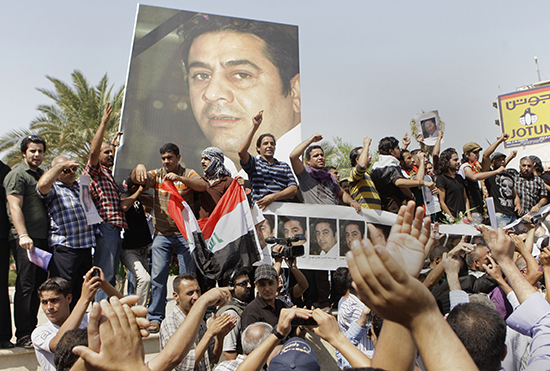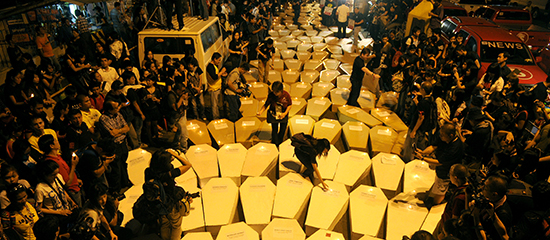Conclusion
Today the fight against impunity has reached an important juncture. There is awareness on domestic and global levels of the extreme peril posed to journalists and the public’s right to information when violence against the press is met with official inaction. The cries for justice by freedom of expression advocates have been amplified by the U.N.’s endorsement and its designation of the first International Day to End Impunity for Crimes against Journalists.
It is also a precarious position—one in which modest gains could easily give way to complacency.
This report has looked at the immense challenges involved in transforming climates of impunity, particularly in areas consumed by conflict or widespread crime and where corruption, cronyism, and political upheaval have weakened the rule of law. CPJ’s analysis of global rates of impunity in journalist killings over the past seven years shows that they have for the most part gotten worse. There are some encouraging signs in the data. The number of convictions of suspects behind these crimes appears to be slightly on the rise, but this number remains small in comparison to the tally of new victims each year.
The Road to Justice
• Table of Contents
Multimedia
• Slideshow
In print
• Download a pdf
In other languages
• Español
• Français
• Português
• العربية
• Русский
At the heart of the problem is a persistent lack of political will to see justice through in the hundreds of cases in which journalists have been fatally shot, bombed, or beaten because of what they were reporting on. In the few instances it has been exercised, usually in response to mounting domestic and international pressure, there has been progress in the form of partial and, more rarely, complete justice for the victims. But the norm is for the suspected perpetrators—politicians, members of the military, and other figures with power and influence in their societies—to escape justice. This pattern particularly applies to those who commission assassinations of journalists.
CPJ sees the devastating effects of impunity daily in stories of self-censorship, exile, and upheaval—but it has also seen that there are ways to combat it.
Over time, in rare but important cases, courageous efforts from relatives and colleagues determined to demand results and question flawed investigations; sustained media attention and campaigning; diplomatic pressure from the international community; and litigation through domestic and regional courts have pushed justice forward or persuaded governments to take more comprehensive steps.

As the report explores, there are a range of measures that states can adopt to ensure safe and fair proceedings. They include marshalling national-level investigative and prosecutorial resources—in some countries, this takes the form of federal involvement in crimes against journalists or freedom of expression—moving trial venues, improving witness protection, reforming judiciaries to limit opportunities for abuse by powerful defendants, and creating independent bodies to scrutinize flawed investigations. Transparency and accountability to victims and the public and close consultation with the media and nongovernmental organizations are keys to successful implementation. A good example can be found in Serbia’s Commission for the Investigation into the Murders of Journalists, in which journalists and investigative authorities have jointly examined old cases and produced new leads, prompting the arrests of suspects in at least one case.
Some of these solutions require extensive resources, legislation, or long-term development of institutional capacities alongside profound improvements in governance. But there are also immediate steps that can be taken that do not require substantial funds or a political sea change. Governments that have professed to convene special inquiries into cases can and should make those results public. The findings of the committee appointed by Kurdistan’s president to investigate the murder of Sardasht Osman and Pakistan’s judicial inquiry into the killing of Hayatullah Khan are two good places to start. Engagement from top investigative authorities on individual cases and the expansion of investigations to include the suspected masterminds should be routine; this trend can be seen in Brazil, where convictions in four cases have taken place in the past two years—including, in one, of the mastermind. In the context of commitments governments have made to address journalist safety and impunity and promote rule of law, these are not tall orders.
Meeting U.N. obligations to combat impunity must now be paramount for member states, starting with thorough and public responses to the UNESCO director-general’s requests for judicial status in cases of killed journalists. Governments should also set high expectations for each November 2 as a time to take a stand against impunity and take honest stock of their progress in solving journalist murders. Each year should bring marked progress by states struggling with high levels of anti-press violence and impunity, and the U.N. should note this progress or its absence in clear terms. Full integration of these concerns into broader areas of the U.N.’s work, such as development goals and rule of law, is also important.
The U.N. Plan of Action for the Safety of Journalists and the Issue of Impunity has opened a new window of opportunity to advance justice by enhancing coordination among state, civil society, media, and U.N. actors. There have been some promising starts, but these are at risk of running adrift if greater efforts, financial and political, are not made to support them and a wider range of U.N. agencies don’t do more to identify their concrete contributions to the plan. At the same time, the media can play an important role by reporting on this process as it unfolds and keeping a strong spotlight on the cases of their fallen colleagues.
The fight for justice is now a global one, but its advancement will come one case at a time. For every suspect tracked down, every perpetrator jailed, and every stalled case reinvigorated, the message grows louder that journalists cannot be targeted without consequence. That message will save lives and improve the essential flow of information at the heart of our global society.
